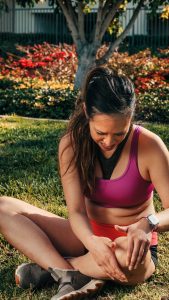
What is ACL (Anterior Cruciate Ligament)?
Anterior Cruciate Ligament (ACL) injuries are a common sporting injury of the knee. It refers to trauma to the anterior cruciate ligament of the knee and can range from a small tear to a full-thickness tear. The ACL is a dense band of connective tissue which joins the femur to the tibia behind the kneecap and is one of the main structures that resist excessive anterior translation of the tibia and excessive internal rotation of the tibia.
Physiotherapists are experts in guiding you through ACL pain.
They Analyse, Review and Prescribe treatment plans that are personalised to you so you achieve the quickest and most effective recovery based on your body conditions.
Conditions that may be related ACL
Due to the mechanism of injury to the ACL, the medial collateral ligament (MCL) is often implicated as well. Although the MCL is thought to mainly provide valgus stability to the knee (preventing the knee from bending inwards excessively), it also resists external tibial rotation (Willinger et al., 2021). The MCL is a fan shaped structure, passing from the medial epicondyle to the tibial attachment site. The fan shape means that the anterior oblique fibres tighten when the tibia is externally rotated and thus it also resists anterior translation of the tibia in this position (Willinger et al., 2021). Other related injuries include meniscus injuries, bony contusions or fractures, joint surface injuries, posterior cruciate ligament injuries, and posterolateral corner injuries.
Common signs of ACL
- Injury occurring after a cutting movement, hyperextension of the knee, awkward landings, or uncontrolled falling weight.
- Audible crack or pop at time of injury.
- The knee feeling unstable or giving way post injury especially with pivoting and twisting the joint.
- Extremely painful injury however with complete ruptures they may experience less pain due to loss of innervation.
- Usually, immediate swelling of the knee joint post injury
- Restricted range of movement of the knee – Difficulty fully extending and/or flexing the knee
- Tenderness on the medial side of the knee.
What causes ACL?
This injury most commonly occurs during uncontrolled pivoting and change of direction movements in sports and occurs with or without contact. The classical position of injury occurs in the dynamic valgus position which is a combination of internal hip rotation and adduction with knee flexion with a planted foot on the ground. This puts excess forces of external rotation at the knee joint which tears the ACL.
How is ACL treated?
After ACL injury, the ACL is rehabbed in 5 phases according to the ACL rehabilitation guide by Cooper (2013):
1. Recovery
After an ACL injury the first thing to work on is the range of motion of the knee. It is common to feel stiff after injury due to tight muscles or a stiff joint from hemarthrosis. The main goals of this stage are getting full range in the knee, settle swelling and get the quadriceps firing.
2. Strength and Neuromuscular Control
The main goal when the joint can move through range again is to regain single leg balance, muscle strength and to be able to do a single leg squat with good technique.
3. Running, Agility and Landings
At this stage, the knee is free of swelling and pain and there is an emphasis on acquiring correct technique for activities such as landing from a jump, pivoting and running.
4. Return to Sport
This stage of rehab is heavily individualised depending upon the goals of the patient. Focus here should be not only getting the knee ready to return to sport but also conditioning the rest of the body, increasing confidence in patient movements and getting mentally ready to return to sport. The patient may start off with restricted training and progressively return to full training at this stage.
5. Preventing reinjury
This phase is incorporated throughout the other phases of rehab. The emphasis here is to aim to create and practice safer neuromuscular patterns during tasks such as cutting, or one legged landing in a sporting environment. This may require training to enable the body to have pristine knee movements subconciously in the environment when the player’s attention is directed elsewhere.
Risk factors of ACL?
Females have 2-8 times higher risk of ACL injury when playing the same sports as men – This may be due to anatomical differences such as smaller size and shape of the intercondylar notch, a wider pelvis, greater Q-angle, and greater ligament laxity. Hormonal differences have been suggested to increase risk of injury as females are more vulnerable in the pre-ovulatory phase(Cooper, 2013).
Other modifiable risk factors include increasing hamstring strength in quadriceps dominant people and learning to land with more hip and knee flexion patterns(Cooper, 2013).
Other causes?
Other causes of ACL injuries are more rare in comparison to sporting injuries. Ristić et al. (2010) surveyed a sample of 451 ACL injury patients and found that 88% were sporting injuries, 11% were caused by everyday activities and 1% were caused by motor vehicle accidents.
References
Cooper, R. (2013). ACL Rehabilitation Guide. In: Australia.
Ristić, V., Ninković, S., Harhaji, V., & Milankov, M. (2010). Causes of anterior cruciate ligament injuries. Med Pregl, 63(7-8), 541-545. https://doi.org/10.2298/mpns1008541r
Willinger, L., Balendra, G., Pai, V., Lee, J., Mitchell, A., Jones, M., & Williams, A. (2021). High incidence of superficial and deep medial collateral ligament injuries in ‘isolated’anterior cruciate ligament ruptures: a long overlooked injury. Knee Surgery, Sports Traumatology, Arthroscopy, 1-9.
